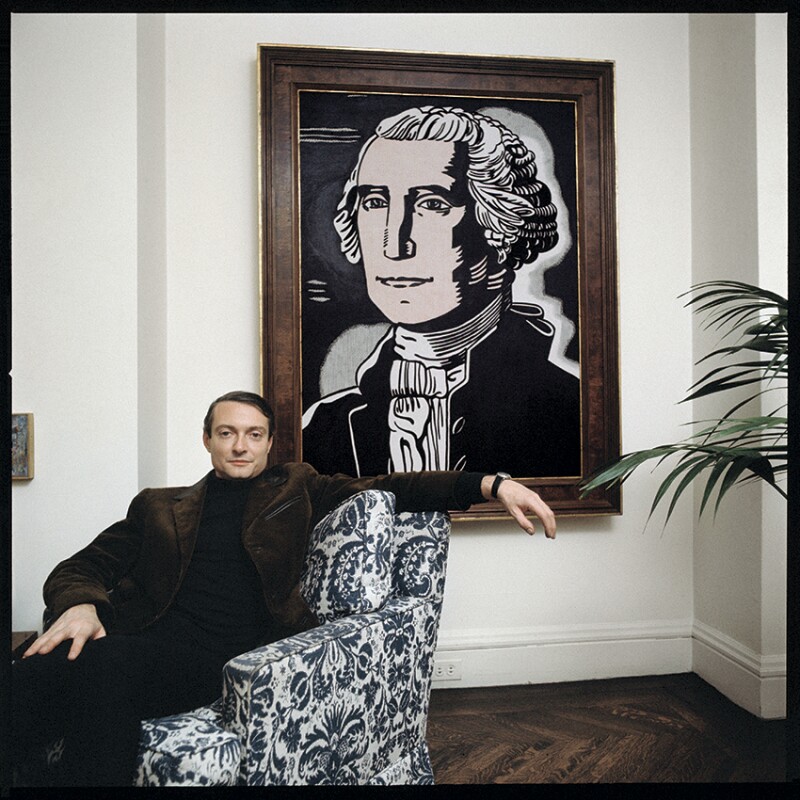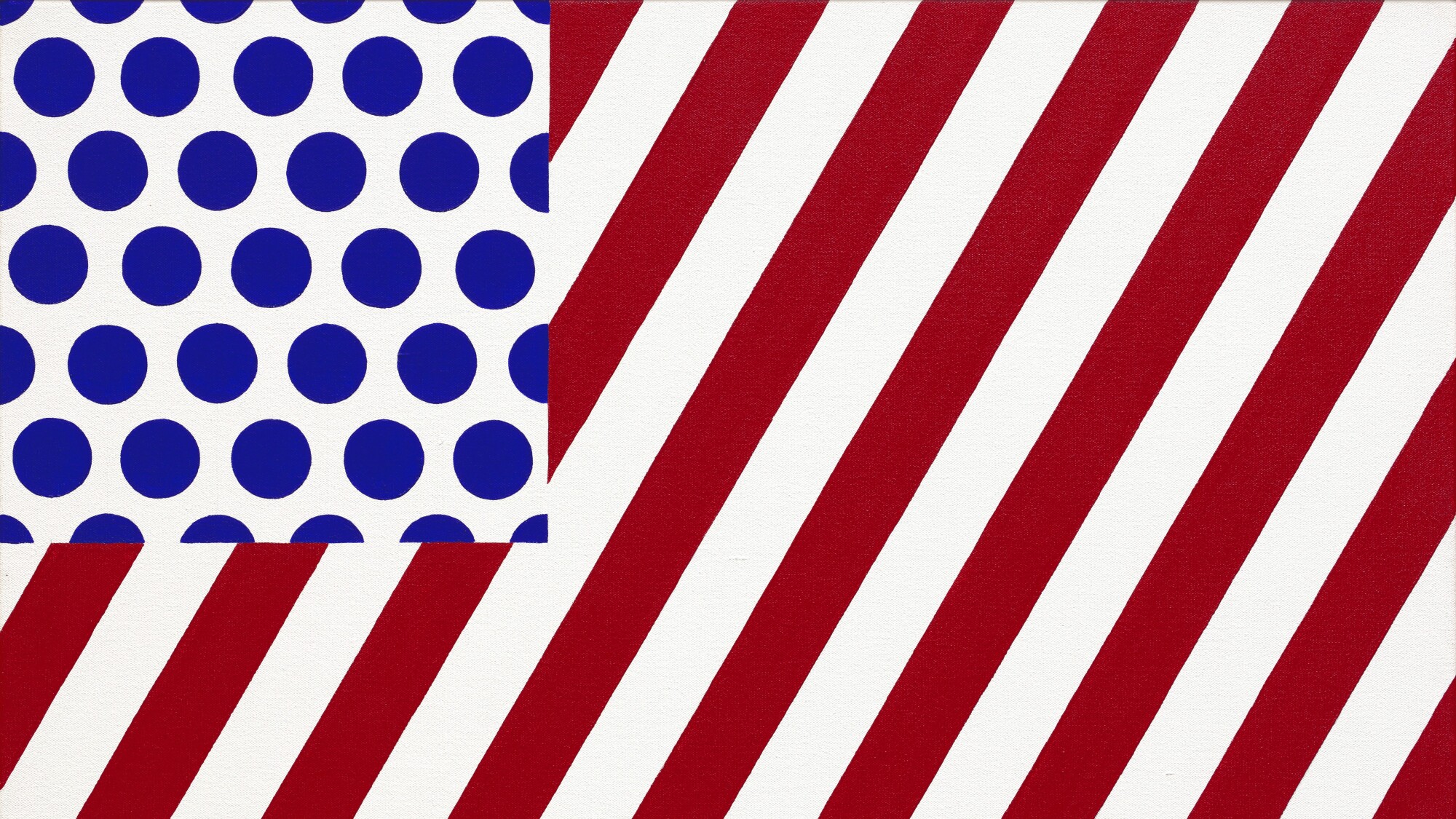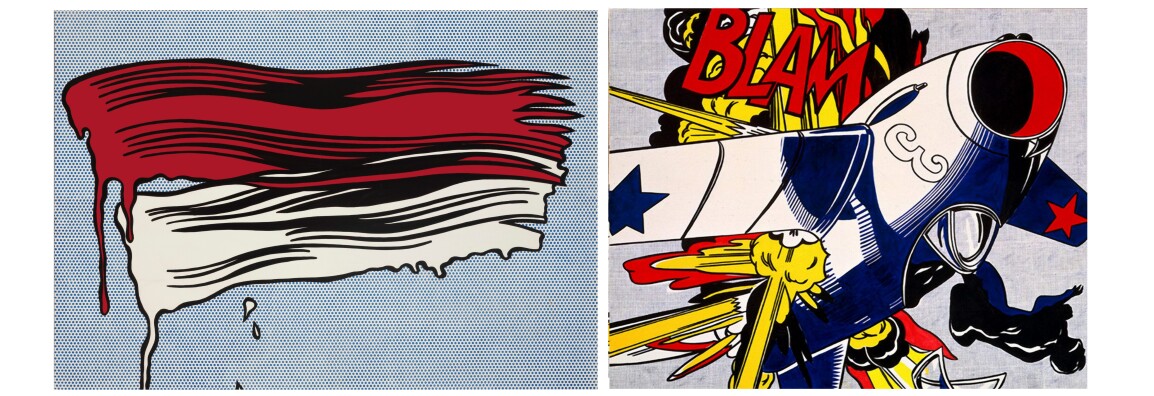
“I’m never drawing the object itself; I’m only drawing a depiction of the object – a kind of crystallized symbol of it.”
An elegantly rendered icon of American pop, Forms in Space from 1985 embodies Roy Lichtenstein's prodigious exploration of commercial art and popular culture. Lichtenstein's hallmark Ben-Day dots, primary hues, and bold lines are instantly within the present work, encapsulating the enduring potency of the artist's signature pop aesthetic and visual language. Few symbols are as visually commanding and well-known as the American flag, which Lichtenstein examines alongside fellow Pop artists Jasper Johns and Andy Warhol as the most iconic symbol of American national identity. Through the diagonal stripes and dotted stars, Lichtenstein explores the mechanisms of perception itself, as the title suggests, examining the symbolic nature of form, space and color. Attesting to the rarity of the present work, Forms in Space is one of a series of only four canvases Lichtenstein produced inspired by the American flag within his oeuvre. Bearing exceptional provenance, the painting was held in the estate of the artist for decades, before being acquired directly from Leo Castelli Gallery by the present owner. A striking composition of saturated colors and searing forms, Forms in Space is a magnificent realization of Lichtenstein's pioneering investigation into form, content, and semiotics.

Taking the American flag as a point of departure, Lichtenstein examines and disrupts the flag's formal qualities, questioning its essence as a symbol. Forms in Space poignantly encapsulates Lichtenstein's unparalleled ability to examine the American psyche through the signs and symbols of twentieth-century consumer culture and, in doing so, raise complex conceptual questions about art and systems of representation. Lichtenstein's oeuvre is predicated on a semiotic investigation of the ways in which systems of representation allow us to conceptualize and interpret the world around us. Like in his 1960s paintings, which appropriated images from popular war comics, Lichtenstein here examines a defiantly American subject matter rendered in a detached commercial style. As Lichtenstein described, "I was interested in anything I could use as a subject that was emotionally strong – usually love, war, or something that was highly-charged and emotional subject matter. Also, I wanted the subject matter to be opposite to the removed and deliberate painting techniques." (The artist quoted in John Coplans, 'Interview with Roy Lichtenstein', Artforum, May 1967, p. 36)


"I am nominally copying, but I am really restating the copied thing in other terms. In doing that, the original acquires a totally different texture."
By appropriating the visual language of machine-printed comic strips in the uniform Ben-Day dots which comprise the surface of Forms in Space, thick, Lichtenstein conflates the culturally resonant mass-produced commercial image of a flag with the traditionally venerated medium of oil painting. Forms in Space sees Lichtenstein culling inspiration from everyday quotidian Americana to create a visually arresting super-reality. Although Lichtenstein’s compositions are most obviously rooted in twentieth-century commercial aesthetic norms, the artist also engaged in a dialogue with canonical art historical conventions. Exhibiting a geometric simplicity and vibrant palette, Lichtenstein’s abstracted forms recall the radical compositions of Piet Mondrian or Kazimir Malevich as much as those of his Pop contemporaries. Through mining art historical precedents and some of the most recognizable symbols within American visual culture, Lichtenstein questions the nature of representation and art itself.


Meticulously interspersing his signature Ben-Day dots and diagonal lines to replace the stars and stripes of the American flag, Lichtenstein explores the artifice of perspective, toying with the mechanics of perception. Even when abstracted in Lichtenstein’s signature pop aesthetic, the red, white and blue of the flag triggers an infallible sense of recognition and unerring certainty within the viewer, which challenges our associations and reflexes. As Lichtenstein describes, “My use of evenly repeated dots and diagonal lines and uninflected color areas suggest that my work is right where it is, right on the canvas, definitely not a window into the world” (The artist quoted in Exh. Cat., Madrid, Fundación Juan March, Roy Lichtenstein: Beginning to End, 2007, p. 52). Here, the profusion of dots and lines seeks not to mirror reality, but instead offers witty commentary on perception and the role of the artist, toying with the dichotomy between reality and illusion. Epigrammatic and playful, Lichtenstein’s Forms in Space defiantly embodies the underlying concerns of Lichtenstein’s career: to examine the signs and symbols that give meaning to contemporary life. Executed in 1985, Forms in Space is emblematic of Lichtenstein’s iconic visual style which has since become synonymous with Pop art itself.

